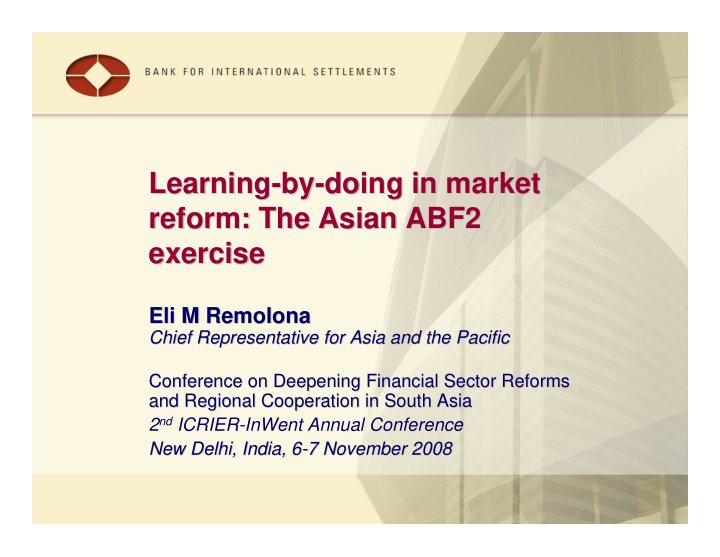



Learning- -by by- -doing in market doing in market Learning reform: The Asian ABF2 reform: The Asian ABF2 exercise exercise Eli M M Remolona Remolona Eli Chief Representative for Asia and the Pacific Chief Representative for Asia and the Pacific Conference on Deepening Financial Sector Reforms Conference on Deepening Financial Sector Reforms and Regional Cooperation in South Asia and Regional Cooperation in South Asia 2 nd ICRIER-InWent Annual Conference New Delhi, India, 6- -7 November 2008 7 November 2008 New Delhi, India, 6
The issues at stake � Why develop local currency bond markets? � Why central banks? � Why do it at regional level? � Why do it through a bond fund? � How to do it through a regional bond fund?
Why develop local currency bond markets? � To provide financial system with “spare tire” � Asian crisis showed short-term credit markets subject to sudden stops � Corporate bond markets can diversify sources of financing � To bring intermediation home � Asians invest abroad at low yields, foreigners invest in Asia at high expected returns � Costly intermediation is being done abroad
Why central banks? � Advocating market reform is costly public good � If private investor lobbies for reform, others would free ride � Central banks more likely than private investors to worry about system as whole � Finance ministries also have role but may have other conflicting objectives -- eg, raising tax revenue � Central banks tend to operate in financial markets and be familiar with them
Why do it at regional level? � Various regional initiatives promote Asian domestic bond markets � By Association of South East Asian Nations (ASEAN) plus China, Japan and Korea (ASEAN+3) � By Executives’ Meeting of East Asia and Pacific (EMEAP) central banks � Initiatives tend to complement each other. � Can lay groundwork for regional integration by pushing for harmonisation and mutual recognition of markets � Peer pressure to fast-track market reforms
Can regional bond funds help? � Asian bond funds are project of EMEAP central banks � In June 2003, EMEAP launched ABF1, investing USD 1 billion in dollar-denominated sovereign issues from eight of the countries � For ABF2, EMEAP has raised USD 2 billion to invest in local currency bonds – but only government and quasi- government � Pan-Asian Index Fund to invest in 8 markets -- not including Australia, New Zealand and Japan but including China � Country sub-funds for each of 8 markets � Subscription initially limited to central banks but soon opened to private investors
The Asian bond fund initiatives ABF2 ABF1 June 2005 June 2003 Launch date Seed money US$ 2 billion US$ 1 billion Local-currency USD-denominated Constituent bonds sovereign & quasi- sovereign & quasi- sovereign in 8 sovereign bonds in 8 Asian markets Asian markets Passively Passively managed Management style managed to bond index to bond index Open to public Only EMEAP Investors
Why do it through a bond fund? � Financial stake is incentive to push hard and get reforms right � In ABF2, 11 central banks have $2 billion at stake � The more open markets receive greater slice of pie � Concerted learning-by-doing an important advantage � Key is process, not size and not whether fund trades actively � Myriad impediments encountered in process
How to do it through a regional bond fund � Start with the simple and easy � ABF1 limited to USD issues but built trust and rapport among central banks � Size of the funds – not so big as to influence markets but big enough to signal serious intent � Build incentives into portfolio structure � Allocation to local markets depends on liquidity and openness as well as on capitalisation and sovereign rating � Allocation will change as liquidity and openness improve
How ABF2 helps open markets � ABF1 was useful since it taught EMEAP how to work together and established principle of pooling reserves � Central banks find setting up of ABF2 to be effective exercise in market reform with “learning-by-doing”: � Lesson 1: Myriad capital controls enforced by making investors report to central banks (or SAFE in China and FSS in South Korea) � Lesson 2: Recognise other jurisdictions � Lesson 3: Lift withholding taxes or simplify procedures for reclaiming � Market reforms complement other initiatives, for example, by ASEAN+3’s Asian Bond Market Initiative
Incentive mechanism for further reforms � Weights for country allocation decided by means of four factors � Market size, 20% � Turnover ratio, 20% � Sovereign credit rating, 20% � Market openness score, 40% � International Index Company (IIC) developed market openness score and responsible for monitoring it � For now, South Korea, Hong Kong, Singapore and China have the most weights
Market weights for the PAIF China Korea China Hong Kong Korea (HK) Singapore Others HK (SG) Others SG Based on market Based also on liquidity cap alone and openness Note: Others comprise the remaining four EMEAP markets of Indonesia, Malaysia, the Philippines and Thailand. Sources: International Index Company (2005b, right-hand panel); BIS calculations (left-hand panel).
Recommend
More recommend